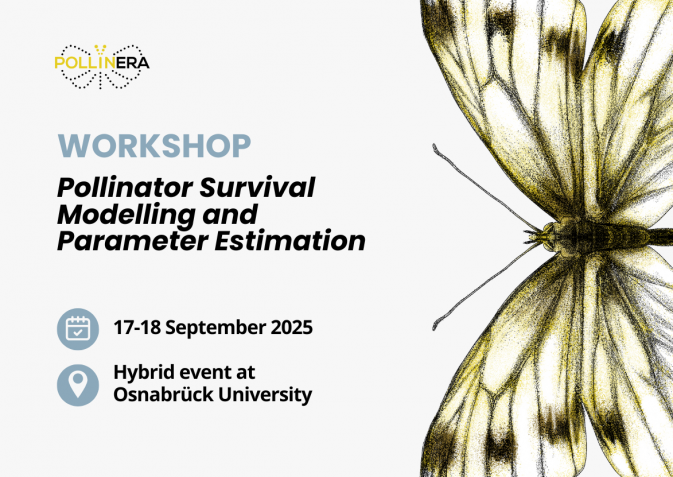Hybrid event at Osnabrück University
PollinERA Workshop | Pollinator Survival Modelling and Parameter Estimation

Join PollinERA's Workshop "Pollinator Survival Modelling and Parameter Estimation"
PollinERA invites you to a hands-on workshop that will explore GUTS and BufferGUTS models and apply them to real datasets. We will learn how to use these models to interpret data, make predictions, design experiments, and discuss applications of these tools in Environmental Risk Assessment (ERA).
Modelling is a tool increasingly creating opportunities for understanding and predicting pollinator dynamics and survival. Toxicokinetic-toxicodynamic (TK/TD) models are mathematical bridges to connect the exposure and effect sides of the ERA of pesticides. As mechanistic process-based models, they estimate effects over time, given an arbitrary exposure profile. In the form of the General Unified Threshold models for Survival (GUTS ) [1], reduced TK/TD models can be calibrated on survival data from simple toxicity tests with repeated measurements over time. These GUTS models have been developed with a focus on aquatic risk assessment, where water is assumed as a simplified path of exposure to chemicals. In terrestrial environments, this assumption no longer applies, and for this reason, a new GUTS model has been developed (Buffer GUTS), capturing exposure events in buffers where pesticides degrade over time [2]. BufferGUTS integrates multiple exposure paths (oral, topical, surface contact) while maintaining the possibility to calibrate the model on simple exposure experiments.
On the first day of the "Pollinator Survival Modelling and Parameter Estimation" workshop, we will explore theory and implementation of survival models, and on the second day, move towards applications of survival models in ERA and discuss uncertainties as well as future perspectives for the use of models in science and regulatory practice.
When: 17-18 September 2025
Where: Hybrid event at Osnabrück University
UPDATE:
⚠️ Due to high interest in the workshop, Day 1 is already fully booked.
👉 Registration for Day 2 is still open!
Interested? Register here.
AGENDA
Day 1: Hands-on Survival Modelling Workshop (17.09.2025)
Target Audience: Graduate students and researchers, Technical Practitioners, Model Developers, Risk Assessors. Ideal for:
- Environmental modellers and ecotoxicologists who want to implement and apply GUTS/BufferGUTS models.
- Graduate students or early-career researchers looking to gain hands-on experience with survival modelling tools.
- Software developers and risk assessors working on Environmental Risk Assessment (ERA) tools or ecological modelling.
What to expect? The focus is on understanding the survival models GUTS and BufferGUTS by getting to know the Python library mempyGUTS [3] and parameter estimation with the open-source model-building platform pymob [4]. We will also interpret model results and look at using models to plan treatment designs.
Speaker: Florian Schunck
Schedule day 1:
The workshop is getting started directly in code with theory provided alongside practical applications.
| Block | Time (CET) | Session |
| 1 | 13:00 - 13:30 | Welcome, introduction & onboarding
|
| 2 | 13:30 - 14:45 | Introduction to GUTS & BufferGUTS modelling with mempyguts |
| 3 | 15:00 - 16:30 | Use of the BufferGUTS model: Parameter estimation & uncertainty quantification based on survival data with Bayesian inference |
| 4 | 16:40 - 18:00 | Application: Interpretation of results and outlook to advanced applications
|
Day 2: Application of Survival Models in ERA & Research Perspectives (18.09.2025)
Target Audience: Policy Makers, Risk Assessors, Risk Managers and Research Strategists. Ideal for:
- Environmental risk assessors and regulatory scientists interested in applying survival models like GUTS and BufferGUTS models in real-world ERA scenarios.
- Researchers and project leaders exploring collaborative or interdisciplinary applications of survival models.
- Stakeholders in pollinator protection, pesticide regulation, or ecological forecasting.
- Decision-makers involved in model validation, data reuse, and regulatory acceptance of modelling approaches.
What to expect? The day promotes discussion, interpretation, and strategic application of models in Environmental Risk Assessment, and the possibility to integrate survival models with other modelling (e.g., ecological models, etc.).
Speakers: Andreas Focks, Florian Schunck
Schedule day 2:
| Block | Time (CET) | Session |
| 5 | 09:00 - 09:20 | Introduction & brainstorming: Modelling at the individual and population levels in PollinERA
|
| 6 | 09:20 - 10:00 | Summary: GUTS, BufferGUTS and parameter uncertainty estimation |
| 7 | 10:00 - 11:00 | Discussion: The potential of TKTD modelling for pollinator ERA
|
| 8 | 11:20 - 12:40 | Breakout session and discussion: Conditions for the use of TKTD models for pollinator ERA
|
| 9 | 12:40 - 13:00 | Conclusion and closing remarks
|
SPEAKERS

Florian Schunck is a researcher dedicated to understanding the ecological consequences of chemical stressors. During his doctoral work at the Helmholtz Centre for Environmental Research in Leipzig, Florian investigated the impact of pesticides on Daphnia magna, spanning individual physiology to community-level responses. He developed strong expertise in Bayesian parameter inference, Dynamic Energy Budget (DEB) modelling, and Python-based data analysis. Outside the lab, Florian enjoys playing Ultimate Frisbee. Now, as a Postdoc at the University of Osnabrück, Florian applies his experimental background and toxicokinetic-toxicodynamic (TKTD) modelling skills to explore chemical impacts on pollinators within the PollinERA project. He is actively developing methods for incorporating omics data into mechanistic TKTD frameworks to enhance predictive power, and he is a passionate advocate of version control and automated testing in software development.

Andreas Focks' research focuses on analyzing and simulating the fate and potential impacts of chemicals and other stressors in environmental systems. He uses a broad portfolio of methods, ranging from differential equation-based exposure models and toxicokinetic-toxicodynamic (TKTD) models for describing the uptake and effects of chemicals at the organism level to equation- and individual-based simulation models (IBM) at the population level. Spatially explicit landscape-scale simulation models are also used. A particular focus is on method development for prospective and retrospective risk assessment.
REFERENCES
[1] T. Jager, C. Albert, T. G. Preuss, and R. Ashauer, “General unified threshold model of survival--a toxicokinetic-toxicodynamic framework for ecotoxicology,” Environ Sci Technol, vol. 45, no. 7, pp. 2529–40, Jan. 2011, doi:10.1021/es103092a.
[2] L. U. Bürger and A. Focks, “From water to land—Usage of Generalized Unified Threshold models of Survival (GUTS) in an above-ground terrestrial context exemplified by honeybee survival data,” Environmental Toxicology and Chemistry, vol. 44, no. 2, pp. 589–598, Feb. 2025, doi:10.1093/etojnl/vgae058.
[3] V. Hundertmark, L. U. Bürger, P. Scharlach, and F. Schunck, mempyGUTS. (2025). Python. [Online]. Available: https://gitlab.uni-osnabrueck.de/memuos/mempyguts
[4] F. Schunck, Pymob. (2025). Python. [Online]. Available: https://github.com/flo-schu/pymob/